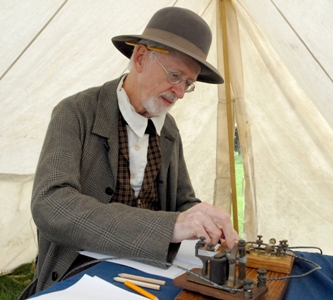FORT MEADE, Md. –
The National Cryptologic Museum (NCM) hosted live exhibitions of Civil War telegraphy and flag signaling on Saturday, 17 September, to commemorate the 150th anniversary of the beginning of the Civil War.

Reenactor Jim Wilson portrays a member of the U.S. Military Telegraph Corps. (National Security Agency photo).
Hundreds of visitors at the NCM saw Civil War reenactors sending and receiving encrypted messages to telegraphers at the National Electronics Museum in Linthicum Md. which held a similar event.
A tent set up as a "signal station" outside the museum also allowed visitors to see how telegraphers operated during the Civil War.
The telegraph revolutionized communications at one of the most crucial times in our young nation's history. For the first time on the northern continent the telegraph allowed commanders to communicate with each other and civilian leadership in Washington within minutes. Messages sent through the telegraph, however, could be intercepted. Unless the messages were encrypted, they could be read by the enemy, making clear the need to protect the information through cryptology.
Visitors also witnessed aerial telegraphy, known as the "Wig-Wag" or flag signaling. A reenactor used specially marked red, white, and black flags to send messages.
Flag signals were also easily intercepted by the enemy. The trick was to encrypt the messages so that they would make sense only to the intended receiver. To send messages, signal officers placed themselves in high elevations where friendly and enemy troops could easily see them. This made signal officers easy targets for enemy sharpshooters.
Soon after the war began, the "Battle Honors" flag, such as the one displayed at the NCM's updated Civil War Exhibit, was designed and awarded only to signal officers for bravery in combat. The points of the star denoted important battles in which the officers distinguished themselves. The flag displayed at the NCM's newly updated Civil War exhibit is only one of two known to exist today in which all five points have been adorned with battle names. The exhibit also displays messages between commanders warning each other of intercepted messages, one of the last existing Union code books, and a replica of a Confederate cipher wheel.
The museum is located at Routes 295 and 32 adjacent to the Ft. Meade, Md., Army post. For more information on the museum, tours, educational programs, and hours and days of operation, visit NSA.gov